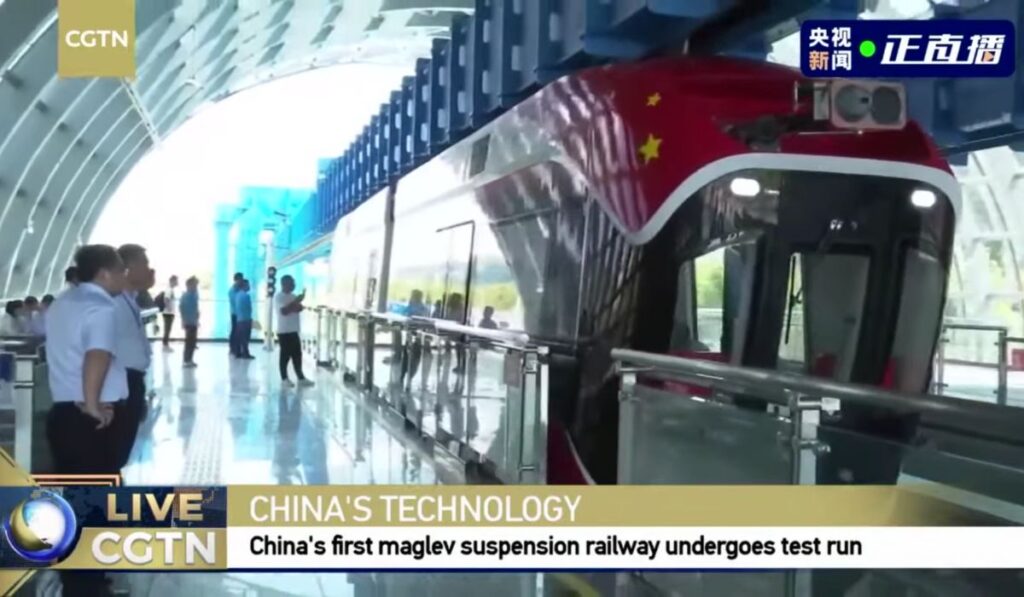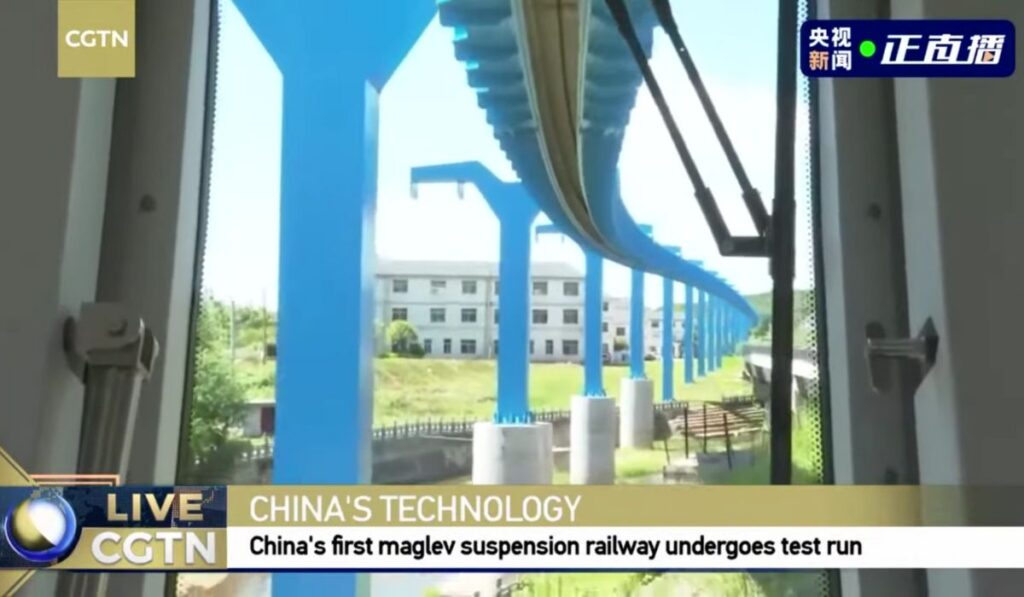China Launches Experimental Suspended Maglev Sky Train.
Chinese researchers claim that the maglev “sky train” uses permanent magnets to float without any power.
This suspended “sky train” operates around 10 meters above the ground and beneath its rail, in contrast to most existing maglev lines.
According to a professor working in the project, the 800-meter experimental Red Rail in southern China offers the possibility of “personalized and intelligent transit.”
China has opened the first suspended maglev line in the world made of permanent magnets that can keep a “sky train” airborne indefinitely, even in the absence of power.
According to a report by state broadcaster China Central Television on Tuesday, the 800-metre (2,600-foot) experimental Red Rail in southern China’s Xingguo county, Jiangxi province, used strong magnets rich in rare earth elements to create a constantly repelling force strong enough to lift a train with 88 passengers in the air.
The suspended rail runs around 10 metres above the ground, unlike the majority of existing maglev lines. As the train travels underneath the rail at a speed of 80 km/h, there is no physical touch with the rail (50mph).
Permanent magnets in the rail and the arm of the train repel one another, suspending the train as a result.
According to scientists from Jiangxi University of Science & Technology, the train can move under free-floating circumstances with no friction using very little electricity.
They claimed that the new maglev technology produced only a little amount of electromagnetic radiation and that its construction cost was only around one-tenth that of a subway.

According to local transportation officials, the line’s length would extend to 7.5 km (4.7 miles) after a few test runs, and its highest operational speed would be 120 km/h.
Maglev lines are being built or planned in numerous Chinese towns. Some trains have a top speed of 600 km/h.
However, the majority of these projects use electricity to power the lift, which not only uses more energy but also creates a powerful electromagnetic field that may have an impact on the local community’s environment and health.
Normal magnets with opposing poles can resist one another, but over time, their magnetic strength dwindles.

A magnet’s lifespan is considerably increased by using rare earth elements. For example, neodymium can lower the loss of magnetism to under 5% over a century. Permanent magnets are therefore those that include rare earth elements.
Industry experts believe that China controls more than 80% of the world’s production capacity for permanent magnets due to its supremacy in the supply of rare earths.
According to an article that appeared in the PLA Daily this month, China has long planned to construct maglev lines utilising permanent magnets and has sponsored numerous research projects with ongoing financing since 2001.
The maintenance of the train’s stability in an unpowered floating state is just one of the difficulties that the suspended maglev technology faces.

However, the article states that Chinese researchers have recently achieved strides in railway control and operational safety using new technology, such as AI.
According to Long Zhiqiang, a professor at Changsha’s National Defence University who worked on the Red Line project, the permanent magnet maglev train is faster and more comfortable than the underground alternative.
The typical domestic underground line’s top speed is 80 km/h, however an AI-driven permanent magnet maglev train may go at a speed of 50% higher.
This allowed the train to maintain its speed even in congested city centres while giving passengers a wide field of vision, “avoiding traffic jams while enjoying the city scenery on the way to and from work,” according to Long.
Long added that because there would be no magnetic pollution or power static, it would also be quieter, even at high speeds.
He said that because the permanent magnetic field could mostly absorb the shocks, it was also challenging for the train to malfunction or sustain damage during prolonged operation.
“The permanent magnet maglev train offers personalized and intelligent transport, which can complement subways and light rail,”
Long was quoted by the PLA Daily as saying.
“In the future, it will also help to create a new engine for the high-end equipment industry and give China a new advantage in leading the world on rail transit.”
Source: South China Morning Post

